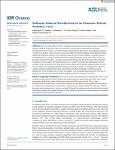Sediment‐Induced Stratification in an Estuarine Bottom Boundary Layer
| dc.contributor.author | Egan, G | |
| dc.contributor.author | Manning, AJ | |
| dc.contributor.author | Chang, G | |
| dc.contributor.author | Fringer, O | |
| dc.contributor.author | Monismith, S | |
| dc.date.accessioned | 2023-05-05T00:43:46Z | |
| dc.date.available | 2023-05-05T00:43:46Z | |
| dc.date.issued | 2020-08-03 | |
| dc.identifier.issn | 2169-9275 | |
| dc.identifier.issn | 2169-9291 | |
| dc.identifier.other | ARTN e2019JC016022 | |
| dc.identifier.uri | https://pearl.plymouth.ac.uk/handle/10026.1/20814 | |
| dc.description | ©2020. American Geophysical Union. All Rights Reserved. | |
| dc.description.abstract |
We took field observations on the shallow shoals of South San Francisco Bay to examine how sediment-induced stratification affects the mean flow and mixing of momentum and sediment throughout the water column. A Vectrino Profiler measured near-bed velocity and suspended sediment concentration profiles, which we used to calculate profiles of turbulent sediment and momentum fluxes. Additional turbulence statistics were calculated using data from acoustic Doppler velocimeters placed throughout the water column. Results showed that sediment-induced stratification, which was set up by strong near-bed wave shear, can reduce the frictional bottom drag felt by the mean flow. Measured turbulence statistics suggest that this drag reduction is caused by stratification suppressing near-bed turbulent fluxes and reducing turbulent kinetic energy dissipation. Turbulent sediment fluxes, however, were not shown to be limited by sediment-induced stratification. Finally, we compared our results to a common model parameterization which characterizes stratification through a stability parameter modification to the turbulent eddy viscosity and suggest a new nondimensional parameter that may be better suited to represent stratification when modeling oscillatory boundary layer flows. | |
| dc.language | en | |
| dc.publisher | American Geophysical Union (AGU) | |
| dc.subject | sediment-induced stratification | |
| dc.subject | boundary layer dynamics | |
| dc.subject | drag reduction | |
| dc.subject | sediment transport | |
| dc.title | Sediment‐Induced Stratification in an Estuarine Bottom Boundary Layer | |
| dc.type | journal-article | |
| dc.type | Article | |
| plymouth.author-url | https://www.webofscience.com/api/gateway?GWVersion=2&SrcApp=PARTNER_APP&SrcAuth=LinksAMR&KeyUT=WOS:000577126400046&DestLinkType=FullRecord&DestApp=ALL_WOS&UsrCustomerID=11bb513d99f797142bcfeffcc58ea008 | |
| plymouth.issue | 8 | |
| plymouth.volume | 125 | |
| plymouth.publication-status | Published | |
| plymouth.journal | Journal of Geophysical Research: Oceans | |
| dc.identifier.doi | 10.1029/2019jc016022 | |
| plymouth.organisational-group | |Plymouth | |
| plymouth.organisational-group | |Plymouth|Research Groups | |
| plymouth.organisational-group | |Plymouth|Faculty of Science and Engineering | |
| plymouth.organisational-group | |Plymouth|Faculty of Science and Engineering|School of Biological and Marine Sciences | |
| plymouth.organisational-group | |Plymouth|Research Groups|Marine Institute | |
| plymouth.organisational-group | |Plymouth|REF 2021 Researchers by UoA | |
| plymouth.organisational-group | |Plymouth|Users by role | |
| plymouth.organisational-group | |Plymouth|Users by role|Academics | |
| plymouth.organisational-group | |Plymouth|REF 2021 Researchers by UoA|UoA07 Earth Systems and Environmental Sciences | |
| dcterms.dateAccepted | 2020-08-03 | |
| dc.date.updated | 2023-05-05T00:43:45Z | |
| dc.rights.embargodate | 2023-5-6 | |
| dc.identifier.eissn | 2169-9291 | |
| dc.rights.embargoperiod | forever | |
| rioxxterms.versionofrecord | 10.1029/2019jc016022 |


